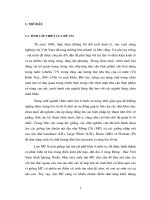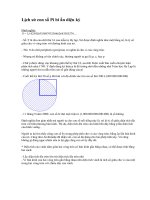CaseStudy PI v8feb11
Bạn đang xem bản rút gọn của tài liệu. Xem và tải ngay bản đầy đủ của tài liệu tại đây (884.16 KB, 7 trang )
Case Study in using the DCED Standard
Bamboo processing in Vietnam with the Prosperity Initiative1
8th February 2011
This case shows a programme using several results chains, with different levels of detail, to
capture its various interventions. Some of these interventions are expected to deliver impact
in the short run, while others will take longer; all, however, are linked through the results
chains to the programme’s ultimate goal of reducing poverty.
Part 1: Summary of Prosperity Initiative’s Experience with the Standard
Description of Programme: The Prosperity Initiative (PI) aims to stimulate investment and
encourage policy reforms that are pro-poor. This case focuses on PI’s interventions in
Vietnam and Laos’ industrial bamboo sectors; the work is funded by a consortium of donors,
and has an initial budget of USD1.1M. The main interventions are:
-
Tailored services to businesses and investors to adopt the most profitable and highest
impact bamboo processing technologies
Policy and advisory services to provincial and national authorities in support of
the bamboo industry and wider socio-economic development
Facilitating the growth of a market for business advice to bamboo producer
communities, particularly around how best to sell high-value aged bamboo
PI works with lead catalytic firms in the bamboo sector by supporting them with business
advisory services to invest and generate new business, to contribute towards growth of the
sector. The project aims to increase the demand for bamboo, which would increase the price
that target groups (small bamboo producers) receive.2
How and Why Prosperity Initiative Became Involved with the Standard: When PI was
founded in 2007, the organisation needed to develop a Monitoring & Evaluation framework
that suited its market-based approach. This was not easy. In the words of Executive Director
John Marsh, most Monitoring and Evaluation (M&E) guidelines ‘are much better suited to
development interventions of a more predictable and direct intervention nature.’
The DCED Standard appeared to offer a viable alternative. In 2008, John Marsh and Bob
Baulch, PI’s poverty specialist, joined the discussions around the content of the Standard. In
2009, PI sent project manager Viet Kim Cuong and a consultant, Philipp Essl, to the DCED’s
introductory course. Shortly afterwards, Jim Tomecko, an expert on the DCED Standard,
1
We thank John Marsh, Philipp Essl and Bridget Lee Dougherty for all of their assistance in preparing this case
study.
2
For more information about Prosperity Initiative, visit www.ProsperityInitiative.org.
visited Hanoi to carry out a mock audit. Philipp Essl oversaw the design of PI’s new M&E
procedures and conducted in-house training on the Standard.
The bamboo project was initially designed in 2007, prior to PI’s engagement with the
Standard. In 2009, at the end of its first phase, the bamboo project was re-designed in line
with a one-year extension by PI’s donors. The project has been refined and simplified as a
result of various challenges and lessons learned in the initial phase. In particular, developing
results chains made a significant contribution to helping the PI team to develop a tighter
focus for the next phase.
Cost and Benefits of Working towards the Standard
John Marsh and his team have prepared a results and project management framework that
captures the various components of the DCED Standard, whilst also meeting donor
requirements such as log-frames. Participation has included attending DCED events (approx.
$7,000), drafting initial results chains and plans with consultancy support ($20,000) and ongoing costs, including a pre-audit ($20,000).
The Standard brings greater clarity and effectiveness to implementation. By using results
chains to examine the logic of their interventions, the PI team has found it easier to link each
activity to development goals, and to decide which ones should be prioritised. Results chains
have also been useful when developing a new log-frame for the bamboo project.
Furthermore, as a dynamic tool, staff can update their results chains when either market
conditions or the project itself changes.
According to Philipp Essl, a former PI consultant, ‘The Standard is more a project
management tool than a results measurement tool.’ For John Marsh, the Standard has also
allowed PI to better plan for and communicate results, both internally and externally. In
other words the cost and time spent working towards the DCED Standard in not only spent
on results measurement but only about gaining clarity about one’s work
Challenges, Responses and General Lessons Learned: Capturing the bamboo project’s
overall impact is not easy, especially as the scale and scope of PI’s activities have evolved
and expanded over time. There have so far been three major challenges.
In adopting the Standard one key concern was how to capture overall impact for the project,
given that the programme was implementing different actions in its first years. Initially, the
team was unclear about the likely intermediate impacts of its interventions. In the redesign,
PI had to spend a lot of time thinking about how to capture its results at different stages, as
different activities would have different timelines for impact: some longer term and some
shorter term. The process of drawing results chains has actually made staff more aware of
these differences.
In the end, after experimenting with a few variations of results chain, it was decided that PI
would consider adopting a hierarchy of results chains to capture all actions that contribute
to PI’s sector level goals. Quoting from PI’s results measurement framework, ‘For each
sector or sub-sector that PI engages in, a sector level results chain is drafted. During the
project development phase (business case) PI drafts an overall project results chain that
summarizes the overall project strategy, as well as the various project components that the
project contains.
Based on the project results chain, project managers develop results chains for each project
component, which provide more details to the project strategy and underlying impact logic.
Depending on the complexity and scope of project components – as well as allocation of
management responsibilities – more than one project component can be captured in one
single component results chain.’
The second major challenge was to capture how PI’s separate interventions and separate
strategies all contribute towards reaching the same desired goal of poverty reduction. Here
again using the hierarchy of results chains helped staff to capture all the actions that
contribute to the programmes’ sector-level goals. This hierarchy of results chains is
explained in detail in the ‘Articulating the Results Chain’ section.
Finally, PI conducted industry level baseline surveys at the outset, to measure household
level impact data, in an attempt to establish benchmarks in line with the longer-term impact
objectives. These surveys were not linked to specific, shorter-term project interventions.
When programme staff drafted results chains for individual shorter-term interventions, it
was not clear how each of these interventions translated into impact. It became clear that
the general household surveys, while interesting, did not allow PI to attribute impacts to
interventions.
Part 2: Prosperity Initiative’s Work towards the DCED Standard:
1.
Articulating the Results Chain: PI has devised the structure for all its results chains
and is finalising the results chains for all its interventions. The main reason for the delay in
finalising results chains is that the project has been restructured recently under a one-year
extension, which started in July 2010. The focus for the project documentation with donors
was the logframe and associated indicators, which has been completed and agreed. Draft
results chains were developed during this process, and fine-tuning is taking place to finalise
the results chains and incorporate other elements of the DCED Standard. In fact, drafting
the results chain has been helpful in this re-strategising process and in developing the
logframe itself, because senior project staff have used it in their key meetings to think
through how their activities can be used to generate highest impact, and how to select the
most appropriate indicators.
PI intends to create results chains at three or four different levels. The first is a sector-level
results chain, incorporating systemic change. Secondly, project-level results chains are
drafted. These show how the different components of the project combine for overall
impact. The third set of results chains are at the component-level. Component-level results
chains show how different groups of activities within one programme component together
lead to higher-level change. As component results chains are drafted to some extent at a
conceptual level, more detailed intervention results chains are sometimes drafted in
addition. Project and intervention managers often find intervention results chains the most
useful. The diagram below shows PI’s hierarchy of results chains for the industrial bamboo
sector in Vietnam and Laos. Annex 1 gives examples of project-level and component-level
results chains.
Already in the project design phase, each staff member is involved in drafting their
respective results chain. This ensures that staff can use the results chains as a practical
instrument to guide their work.
Results chains have been updated and improved over time. For example, PI originally
projected the amount that target firms would invest, without linking this explicitly to its
outputs (e.g. deals made, services provided). Closing this gap has helped to clarify the
project’s logic.
2.
Defining Indicators of Change: PI aims to integrate the indicators used in its logframe into its results chain. This will deepen the explanation of PI’s intervention strategy by
providing additional information on indicators, means of verification, assumptions (risks) and
required resources. This will also help them to measure what is important and to avoid
duplication of work.
PI aims to measure the long-term impact of its various activities on poverty reduction. This is
difficult to do with a high degree of scientific rigour, however, because many factors
contribute to poverty. As suggested in the Standard, PI also measures how many people
benefit from its interventions, plus the additional jobs and additional income going to poor
people as a result of its interventions. The PI team use these indicators to establish whether
their work is achieving its goals. PI develops projections for the following standardised
impact indicators:
Producers’ income from sales
Target groups’ income from salaries
Total number of new waged jobs created (Full-time Equivalent)
% of new jobs going to female workers
Total Income: the sum of all household income from sales and wages.
Measuring Changes in Indicators: Although PI is not yet at a stage where it measures
changes in indicators, PI has designed a method for measuring changes in indicators in its
Results and Project Management Framework. This methodology aims to conform with good
research practices, as outlined in the Standard. It includes quick household surveys, semi3.
structured interviews and focus groups, as well as available secondary data on poverty.
PI has a poverty scorecard methodology, which allows for the classification of households as
poor, near-poor, or non-poor, based on a number of non-monetary poverty indicators that
are covered in a brief interview with a household member. PI piloted this method in its first
firm-based impact assessment, carried out in early 2009. It will next be applied to partner
firms which make investments, both to capture baselines and to measure the impact of the
investments that these firms make.
4.
Estimating Attributable Changes: PI has
prepared a draft attribution measurement plan,
but has not yet tested it. The plan is illustrated
in the diagram. As more programmes apply the
Standard, John Marsh hopes that there will be
more examples of how programmes have dealt
with the issue of attribution.
Results Chain
Level of change
Attribution Methods
• Case studies
Poverty impact
• Quasi-experimental (household
income) surveys
• Case studies
Outcome
(Enterprise/government
& sector level)
• Sector stakeholders’ opinions
• Quasi-experimental surveys
• Trend analysis
5.
Capturing Wider Changes in the System
or Market: Systemic change is included in PI’s
sector-level results chains. The project
•Case studies
Output
• Sector stakeholders’ opinions
considers, for example, how increased demand
for bamboo generated by PI’s interventions
would also increase the price that target groups
receive for their bamboo. In practice, it has proven difficult to establish precise causal
relationships between PI’s interventions and systemic impact. The size of PI’s budget and the
likelihood that the project will end in mid-2011 mean that PI is unlikely to measure systemic
change in detail.
6.
Tracking Programme Cost: PI’s accounting system, managed by the operations
manager, measures all the programme’s costs annually.
Reporting Results: PI has developed a corporate reporting system to measure its
effectiveness. This system also measures compliance with the DCED Standard and with
donor requirements. The system includes time reporting for staff, and regular strategic
review meetings, once or twice per year.
7.
Annex 1: Sector-level and Component-level Results Chain for PI’s work in industrial bamboo
Sector-level:
Component-level, relating to Business and Investment









